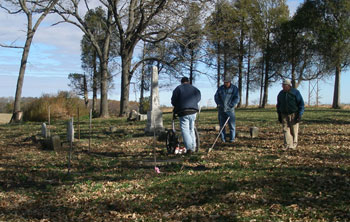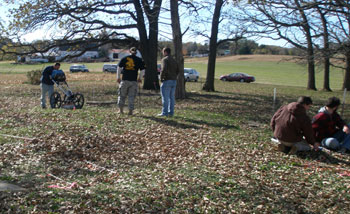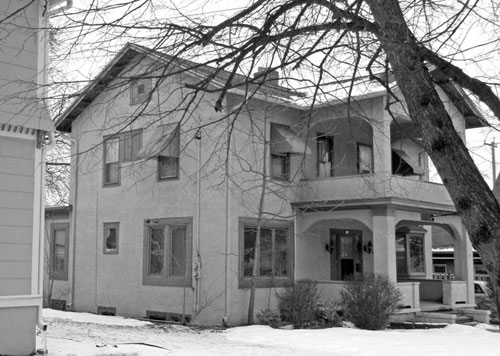Newsletter - March 2011
Burlington Historian

March 2011

Additional Gravesites Found at Mt. Hope Cemetery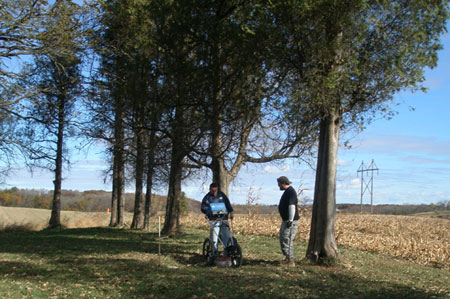
A ground-penetrating radar scan (seen in progress at right) of Mt. Hope Cemetery in October 2010 identified more than a dozen gravesites that had not been previously known. The scan was done by Nathan Machel, Regional Director for Ground Penetrating Radar Systems, Inc., an Illinois firm, on behalf of an anthropology group from Wisconsin Lutheran College, led by assistant professor of Anthropology Ned Farley, in cooperation with the Burlington Historical Society.
The 77 by 77 yard cemetery, on a hill on the Robert and Dorothy Stowell farm just off Spring Prairie Road west of county trunk DD, is one of the oldest cemeteries in the Burlington area. It is the resting place of Palmer Gardner, the first settler in Walworth County, and his first wife and daughter, as well as of Charles and Mary Galusha Dyer, the parents of Burlington’s first physician, Dr. Edward G. Dyer. Charles Dyer was the first owner of the land, having bought it from the government in 1839. A brother and sister of Dr. Dyer are also buried there.
Besides those seven people, the Burlington Historical Society has, over the years, identified eighteen other persons, or a total of twenty-five, who were buried in the cemetery from 1846 until 1888.
The radar scan revealed a total of 37 underground areas, or air pockets, that appeared to be gravesites. Some of the 37 were larger than the others and could have contained two or more graves.
The gravesites detected by the radar scan were outlined with stakes and ribbon and will be mapped by Professor Farley and his students.
The college and the Historical Society have been working together since 2007 to clean up and map the cemetery, which has gone from a thickly overgrown plot to the cleared area evident in the first photo at right. A lot of the recent improvement in the appearance of the cemetery is due to the dedication and work of Society member and Walworth County historian, Ken Amon, who has "adopted" the historic site.
Right: Two Wisconsin Lutheran College students watch the ground-penetrating radar machine at work, while Professor Ned Farley and another student outline one of the gravesites detected by the machine.
President’s Message
With the bustle of the holiday season behind us, it’s back to the excitement of planning for a new year. We have our newly remodeled and enlarged museum to show off to the community and want to remind all members to spread the word to family and friends to stop in on a Sunday afternoon to see our new displays. We also encourage the younger generations to participate in a tour of our past. It helps build a knowledge of the challenges our forefathers contended with just to live a simple and modest lifestyle.
Again, we have seen many changes around our community with the addition of a new hotel and the parking structure downtown. It makes it difficult to remember the way it looked just a few years back. Thanks for being a member of our Burlington Historical Society and drop us a note or send us an e-mail to share some thoughts you may have on the history of the Burlington community.
If you have photos relating to the history of Burlington or the surrounding area that you would like to share with us, we would welcome those, too. If you bring those to the museum, we can scan them and return the originals to you or, if you have them already scanned, you can e-mail them to us at the address shown on the first page. We usually do our scans at a minimum of 300 dpi and at an 8 by 10 inch size.
Dennis Tully
Pioneer Cabin to Re-Open in May
Pioneer Log Cabin, which has been closed for the winter, will be opening again in May. We usually start the first Saturday afternoon in May, weather permitting. We also plan to open the Cabin on Thursday evenings to coincide with the Farmers Market, which is held in Wehmhoff Square.
The Society is always looking for new Cabin docents. If you are interested in volunteering, please contact Jackie Heiligenthal, 262-661-4272. Training is free and the rewards are great!
Outstanding Christmas Program
Despite one of the worst weekends weather-wise during the winter of 2010-11, a good number of hardy souls attended the Society’s Christmas program at Veterans Terrace on Sunday, December 12, 2010, when Wisconsin author Rochelle Pennington presented the story of the wreck of Lake Michigan’s Christmas Tree Ship, the Rouse Simmons, in the "Great Storm of 1912."
Ms. Pennington also told of the life of the ship’s captain, Herman Schuenemann, and the efforts of his family, after his death, to carry on the tradition of delivering holiday evergreens to the citizens of Chicago. Ms. Pennington illustrated her talk with many photographs and brought along several artifacts, including an axe and the trunk of one of the trees that had been salvaged from the sunken ship.
Thank You, Rotary Club
The Burlington Rotary Club presented a gift of $1,000 to the Historical Society on behalf of Don Vande Sand, the Society’s vice president, who was honored by the Club with its 2011 Humanitarian Award. Vande Sand received the award for his work in preserving the area’s history, helping others with historical and genealogical research, and being the volunteer Museum curator.
Old Academy Building Made Into Dwelling -- History of Past Recalled When Carpenters
and Masons Alter Old School House
(from August 19, 1920, Free Press)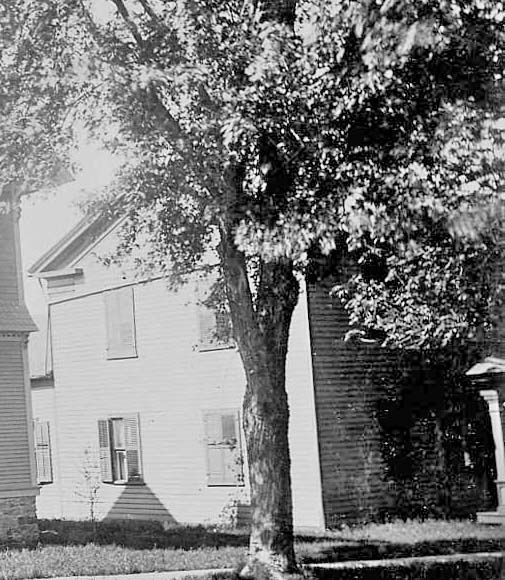
What is commonly known as the old “Dr. Lewis Academy” on Jefferson street will be a thing of the past when those working for Jacob E. Wien will have completed their task of making a modern house out of it.
With the pebble dashing of the building the last vistage of the traditions of 1844 will be wiped out. All that will remain is the memory of the past. And this, too, will die with the passing of our fathers.
(The photo at right, taken in 1898, shows the west side and part of the front of the old Burlington Academy building on Jefferson street between what is now N. Kane street and N. Perkins boulevard. The photo below, taken in 2011, shows the building as it looks today. The building was substantially remodeled in 1920 as the accompanying article from the Free Press of August 19, 1920, describes.)
The old “Dr. Lewis Academy” holds many tender memories, sacred to those long gone. It is one of the unmodernized connecting links to the days when stiff beruffed pink sunbonnets and pig tails were in style. It is a picturesque building even now that it is under the ruthless hand of an improver. The voices that rang in merry laughter through the ancient hall of learning have long been hushed – their voices live now in their children and their children’s children.
The history of the school house on Jefferson street is one that has never been sung by poet’s tongue or featured in a novelist’s romance. It was – that’s all. In a book describing Burlington schools published in 1898, there are a few facts concerning the time-worn institute. That outstanding all others is that the Burlington Academy was incorporated by an act of the legislature in 1844. Pliny M. Perkins, Origen Perkins, Dr. Edward G. Dyer, and Nelson R. Norton were the incorporators.
The Academy building was erected on Jefferson street just east of the Baptist church (now the Church of the Nazarene). R. D. Turner was the first teacher, followed by Mr. Coffin, Mr. Baker, Leander F. Frisby, afterward attorney general of Wisconsin, Hon. John F. Potter, the well-known congressman, and Dr. Lewis.
In 1857 citizens of Burlington awoke to the need of a public school system. After considerable delay, the present-day plan of schools was formulated. The academy eventually went out of business, at least nothing further is heard of it after 1860.
The carpenters and masons at work at the new Wien house have found no further historical data upon which to build a past, not even a hickory switch that might hold future generations in check.
Meanwhile Joe Rueter and his force of carpenters are continuing to remodel the interior, a new room here, an alcove there and a sun porch 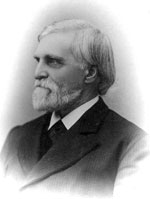 on the side. There will be ten spacious rooms in all – halls lead confusingly into each other. Joe Brooks, the mason in charge, has commenced the cellar and has orders to pebble dash the house.
on the side. There will be ten spacious rooms in all – halls lead confusingly into each other. Joe Brooks, the mason in charge, has commenced the cellar and has orders to pebble dash the house.
John Fox Potter (right), sometimes known as “Bowie Knife” Potter, was one of the teachers at the Burlington Academy. He later practiced law and was elected to the U.S. House of Representatives.
"This Is The Way We Wash Our Clothes . . ."
Contributed by Priscilla Crowley
Remember what washday used to be like? Remember the intricacies of the wringer washing machine and having to hang everything out on the line to dry? It was a huge step above using a washtub and an old washboard but a far cry from the conveniences of today.
When we first moved to Lyons, our little house didn’t have running water so, when wash day came around, water had to be hand pumped and then heated on the stove top – gallons and gallons of it. Later on, my parents invested in a water heater that had to be hand filled but would heat water up fairly quickly for things like dishes, baths, and laundry.
Laundry day was always an adventure for the three of us kids – not so much for Mom. Of course, we always wanted to "help." After all, isn’t that what kids are for – to be helpful? Unfortunately, our definition of help and Mom’s definition of help seemed to come from two different dictionaries. Kids always had a different dictionary for the meaning of words than adults did. To us, "help with the laundry" meant splashing around in the rinse water, poking a stick at the clothes in the washing machine to make sure all the clothes were submerged in the wash water, and the best part of all – feeding the clothes through the wringer. That was just one of the best parts of laundry day.
Mom was an extremely nervous person and I can’t tell you how many times we heard, "Get away from that wringer – do you want to get your arm stuck? Now go on, get out of here – you’re not helping. Do you want that wringer to tear your arm off? – how would you like that? – there you’d be with only one arm – how do you think you’re going to get along with one arm? Now get!!!"
Well, we’d go slinking out into the yard for a little while but pretty soon we’d be right back there again, promising to never touch the wringer again, we just wanted to "help." No wonder she was exhausted at the end of the day. It wasn’t the laundry – it was us. By the time the laundry was washed, we were wet from head to toe. We were very enthusiastic about making sure the clothes were rinsed properly.
Hanging the clothes on the line was another part of the adventure. We were too short to reach the clothesline but we could hand her stuff to hang on the line and we could hand her clothespins. Then when she went in the house we could play hide and seek in and around the clean clothes. That was great fun – the clothes smelled so good hanging out in the sunshine and fresh air. Unfortunately, sometimes we really got carried away and 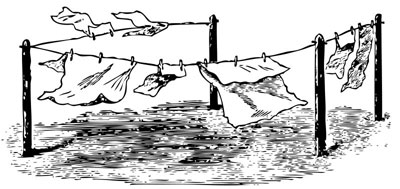 she would come outside to find little handprints on the clean sheets or, worse yet, clothes pulled off the line and laying on the ground. We were smart enough to evacuate the area once clothes hit the ground – we figured if weren’t around, we could always say one of the neighbor kids cut through the yard – she wouldn’t believe us but it was worth a shot.
she would come outside to find little handprints on the clean sheets or, worse yet, clothes pulled off the line and laying on the ground. We were smart enough to evacuate the area once clothes hit the ground – we figured if weren’t around, we could always say one of the neighbor kids cut through the yard – she wouldn’t believe us but it was worth a shot.
We were also great at folding clothes. Mom just loved it when we did that. Sometimes she sent us outside to take the clothes down if she was running late and needed to start supper. We weren’t quite tall enough to reach the clothesline so we had our own methods for getting the clothes off of the line. Socks were really tough because they didn’t hang down very far. For those, you had to take a running start and sort of leap up and grab them and hang on. If you were really good, you got the sock and clothespin in one leap. Of course, we had an issue with under-wear – we girls didn’t want to touch our brother’s underwear and he really didn’t want to touch ours. The exchanging of boy and girl cooties was a bad thing and we tried to avoid it whenever possible.
By the time we took all the clothes down everything was in a jumble, we had clothespins mixed in with the clothes and our idea of folding was to cram as much as we could into the basket and then drag it towards the house screaming, "Mom we got the laundry." It just about broke our hearts when Mom and Dad invested in a clothes dryer. Laundry still got hung on the line on nice days but it was never the same.
Because all the sheets had been washed, we now had another opportunity to be helpful. All the beds had to be re-made. We could certainly help with that. What should have taken a half hour at the most stretched into at least an hour. With all of the help Mom had, it took forever to put the beds back together again. Most of the time the pillow would only be partially stuffed into the case and blankets would be spread helter skelter any which way across the bed. Instead of the bedding being nice and smooth across the mattress, there were unexplained lumps and bumps everywhere. She would have to go behind us and straighten out and tuck in the sheets and then make sure we had actually put pillowcases on the pillows. Bed making just wasn’t bed making unless you could bounce up and down on the bed a few times. That was the best part of all – but it really didn’t have Mom’s wholehearted approval.
Looking back, I realize that you could watch Mom slowly unravel as the day went on. By the time we had helped her with the wash, helped her take the clothes off the line, helped her fold the clothes, and then helped her re-make all the beds, you could see that her patience level was down to just about nothing. I’m sure she enjoyed laundry days much more when we were all in school.
Dad always took care of emptying the wash machine and the rinse water tub. The fun just never stopped on washday. By the time we "helped" him with these chores we were wet from head to toe all over again and full of dirt and mud besides. By the time Mom got us cleaned up, it was time for bed. I’m sure that no one looked forward to bedtime on washday as much as Mom did. We had a different outlook – as much fun as washday was, we were looking forward even more eagerly to ironing day and grass-cutting day. Then we could help both Mom and Dad. Life just didn’t get any better than this.

The following article ran in the July 26, 1928, issue of the Free Press. The millpond is now known as Echo Lake. Norris’ Point is the area at the northwest corner of what is now Echo Park (see October 1975 photo below). At the time of this incident, the area was private property with nearby houses. About a week after the article ran, the city bought the property for use as a city park.
Nude boys who dive froglike into the millpond at Norris’ Point were threatened with a new punishment by Police Chief Frank Beller this week.
Four shiny-faced slick-haired and visibly frightened lads were haled into the station charged with diving au naturel into the millpond and shocking residents nearby.
They were threatened with having their heads shaven in punishment after Motorcycle Officer Charles Wilson had made a flying trip to the Point in response to telephoned alarms.
If the entire boyhood of Burlington is made bald, nude swimming must stop and children who revel in the warm waters of the millpond must don swimming trunks to preserve public decency, the chief warned.
Norris’ Point for three generations has been the retreat of local boyhood who love to go in bathing with no other garb but Nature’s.

